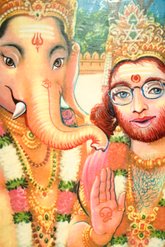
"The path to Han Shan's place is laughable,
A path, but no sign of cart or horse.
Converging gorges-hard to trace their twists
Jumbled cliffs-unbelievably rugged.
A thousand grasses bend with dew,
A hill of pines hums in the wind.
And now I've lost the shortcut home,
Body asking shadow, how do you keep up?"
-Han Shan (between 630 and 830 C.E.)
translated by Gary Snyder
The Appalachian Trail is a beast. A "foot path" 2,175 miles long and usually just a few inches wide, the A.T. slithers across 14 U.S. states-up and down mountains, through small towns and near enough to New York City to glimpse it through it through the smog, across swamps, streams, pastures where cattle graze, and ridge lines where hawks soar. The Appalachian Trail as a contiguous unit was completed in August of 1937, but some parts of it are much older. In North Carolina and Tennessee, large trees twisted into unusual "L" or "S" shapes are a common sight. These are not natural phenomenon, but were trained by Indians who would twist saplings into unusual shapes in order to create trail markers. The 40-mile section of the A.T. in Maryland (some of the easiest hiking on the whole trip) was used to run supplies and troops by both the Northern and Southern armies during the American Civil War (1861-1865.) In 2006, I was one of the 500+ people lucky enough to successfully hike the entire trail from its origin on Springer Mountain in Georgia (outside of Atlanta) to its terminus on Mount Katahdin in Maine (outside of Bangor.) Hiking the entire A.T. in one year is known as a "thru-hike." Hiking the entire A.T. over the course of a number of years is known as a "section-hike." Like a lot of people, I got my first taste of life on the trail from reading Bill Bryson's book about his 1996 attempt at an A.T. thru-hike, "A Walk In The Woods." Though I have since discovered that portions of the book are distortions or outright fiction, I still recommend it to people who ask me about the trail because it is entertaining and the information in the essay sections of the book is accurate (if a little out of date now.) Everybody on the trail has an opinion about Bill Bryson, and the word "muthafucka" usually features in it somewhere, but I'm grateful to him for opening up the world of long distance hiking to me. The first thru-hike was completed by WW 2 vet and Pennsylvania native Earl Shaffer in 1948. Since the 1980's thru-hiking the A.T. has become an increasingly popular activity. Each year somewhere between 1500-2500 hikers begin a hike with the intention of walking all the way to the other end-with anywhere from a 15-25% success rate on any given year. Exact numbers concerning the A.T. and its hikers are estimates, because people are not required to officially register in most places and almost everyone uses pseudonyms or "trail names." We didn't all walk around with T-shirts that said "THRU-HIKER" or carry around any special papers. A thru-hiker is just somebody on a really really long walk in the mountains. About 90% begin on Springer Mountain and walk North, like I did. These folks are called Northbounders. And most of the rest start at Mount Katahdin and hike South. These folks are called Southbounders. In this short series I am not going to give you a day-by-day account (ZZZzzzzzz) of my thru-hike, but instead share some stories, information, snapshots, and advice for planning your own long-distance hike. I did a lot of things right, but also made quite a few mistakes along the way. There are as many ways to hike the A.T. as there are people who hike it. If you ask 10 hikers what constitutes a successful thru-hike, you will get at least 50 different opinions. Everything from, "burn up as many miles as super-humanly possible with a pack the size of a hummingbird's nest or you're a loser," to, "I walked until it wasn't fun anymore and then I stopped. Are those Sour Cream and Onion chips, dude?" I've seen people who were in fantastic shape with the best gear burn out or break their ankles in the first week. And I've shaken hands on Katahdin with middle-aged guys with pot bellies who drank beer and smoked the trees the whole way. To quote Chuck Berry, "you never can tell." You don't know what's in your heart until you put it to the test. Many of the people who have hiked the A.T. in recent years have posted their thoughts on the "Trail Journals" web site. If you are interested in this series, you can find many more related stories at: http://www.trailjournals.com/ If you are researching your own hike (1 day or 100) on the A.T. a good place to start is on the Appalachian Trail Conservancy (A.T.C.) web site: http://www.appalachiantrail.org/



No comments:
Post a Comment